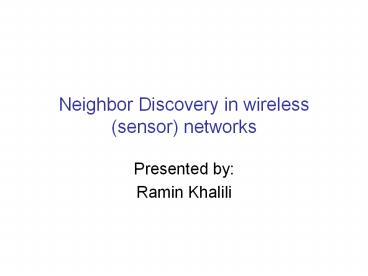Neighbor Discovery in wireless (sensor) networks - PowerPoint PPT Presentation
Title:
Neighbor Discovery in wireless (sensor) networks
Description:
... Discovery in wireless (sensor) networks. Presented by: Ramin Khalili. Neighbor ... Nodes discover their neighbors as quickly as possible. Energy efficiency ... – PowerPoint PPT presentation
Number of Views:129
Avg rating:3.0/5.0
Title: Neighbor Discovery in wireless (sensor) networks
1
Neighbor Discovery in wireless (sensor) networks
- Presented by
- Ramin Khalili
2
Neighbor Discovery
- Determination of all nodes a given node may
communicate directly - First step in self-organization process of a
ah-hoc network - Essential for routing medium-access protocols
- Important enabler of Network connectivity and
energy conservation
3
Rapid discovery
- Nodes discover their neighbors as quickly as
possible - Energy efficiency
- Other protocols quickly start their execution
- Goal maximize discovery probability of neighbors
(PD) within a given amount of time (TD)
4
Classic algorithms
Node 1
Node 2
Collision
Success
Success
Free
time
T
3T
2T
0
TD4T
- Transmits with probability pT listens with
probability (1-pT) - Finding optimum pT to maximize PD
- PD1/N Nnumber of nodes in network
5
Assumption I
- N is know a priori
- Using an estimation of N
- Under-estimate more collision
- Over-estimate more free slots
- Estimating N using collision information?
- Can be also useful when N is not fixed
- Addition of new nodes
6
Assumption II
- Nodes are synchronized
- Suddu et al. asynchronous algorithm
- Listen intervals exponentially distributed with
rate ? - Transmission duration ??0
- Twice time for same PD
listening
transmitting
7
Assumption III
- Nodes know when the algorithm begin
- Ephremides et al. algorithm
- Most of nodes in LOM Listen Only Mode
Reception (pR?) or Sleep (ps1-?) - Rest on DM Discovery Mode
- Node transmits from LOM to DM if
- In state R
- Receive message
8
Discussion
- No collision information at transmitters
- No info. about reception of msgs continue
transmitting - Increasing redundancy resource (energy time)
consumption - a priori estimation of collision may improve
performance
9
Code-based protocol (Keshavarzian et al.,
Infocom04)
c1 ( 0 1 1
0 0 1 )
- c1 codeword of length F6
- Transmits if c1(i)1, listens if c1(i)01 ? i ?
F6 - Each node has a unique codeword
10
Constant-weight codes
- C(F,W,d) constant-weight code
- Binary code
- F length of code
- W weight of code number of 1s
- Number of transmissions
- d minimum distance between any a,b ? C
- d a ?2 b
11
Collision analysis
c1 ( 0 1 1
0 0 1 )
collision
c2 ( 1 0 1
1 0 0 )
- For any a,b ? (F,W,d)
- ? max of collision positions between a b
- ?W-d/2
- W 1 ?N guaranties at least one successful
reception
12
Energy consumption
- Suppose C(F,W,d) when W 1 ?N
- ETX ERX energy consumed in transmit receive
state - Enode WETX (F-W) ERX
- Optimum design to minimize Enode
- ?1
- W1N
- F ? W2
13
What if W 1 ?N
- As ?1 two nodes collide max in one position
- Probability of this collision less than W2/F
- N nodes, total collision
- Binomial(N, W2/F)
- PD can be calculated
14
PL1-PD
15
Comparing with random protocols
- Suppose F, time slots, same for both random and
coded-based protocols - Random protocols
- W ? pTF ( transmissions per node)
- ? ? (pT)2F ( collision between any two nodes)
- Coded-based protocols
- W ? F1/2
- ? ? 1
16
Discussion
- Require synchronization
- Estimation node in network
- What is probability that two nodes pick same
codeword - What if links are lossy
- Collision estimation might not be enough
- Receiver state at transmitters??































